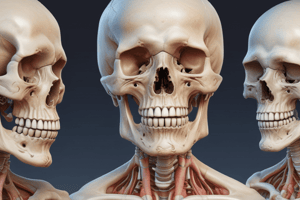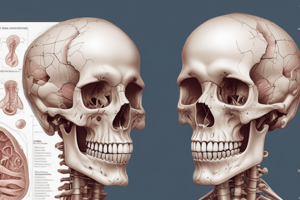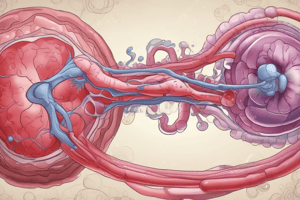Podcast
Questions and Answers
What is a common characteristic of osteoma?
What is a common characteristic of osteoma?
- Malignant transformation is common
- Usually asymptomatic (correct)
- Presents with systemic symptoms
- Affects the epiphysis of bones
Which abbreviation refers to a condition with Brown tumor formation?
Which abbreviation refers to a condition with Brown tumor formation?
- ABC
- CMF
- HPT (correct)
- EG
In which bone region does Ewing sarcoma primarily occur?
In which bone region does Ewing sarcoma primarily occur?
- Epiphysis
- Metaphysis
- Diaphysis (correct)
- Physis
What is a distinguishing feature of chondromyxoid fibroma?
What is a distinguishing feature of chondromyxoid fibroma?
What is a characteristic feature of giant cell tumors?
What is a characteristic feature of giant cell tumors?
Which bone tumor is known for its association with hyperparathyroidism?
Which bone tumor is known for its association with hyperparathyroidism?
What is the site of osteoblastoma typically found in?
What is the site of osteoblastoma typically found in?
What symptom helps differentiate osteoid osteoma from osteoblastoma?
What symptom helps differentiate osteoid osteoma from osteoblastoma?
Which bone tumor is described as a 'giant osteoid osteoma'?
Which bone tumor is described as a 'giant osteoid osteoma'?
What is the most common 1° malignant tumor of bone?
What is the most common 1° malignant tumor of bone?
Which age group is most likely to develop osteoid osteoma?
Which age group is most likely to develop osteoid osteoma?
How does the pain in osteosarcoma typically respond to aspirin?
How does the pain in osteosarcoma typically respond to aspirin?
What aspect of bone tumors does the saying 'Location! Location! Location!' emphasize?
What aspect of bone tumors does the saying 'Location! Location! Location!' emphasize?
What is a distinguishing feature of an osteoma?
What is a distinguishing feature of an osteoma?
Which bone tumor is known for its association with hyperparathyroidism?
Which bone tumor is known for its association with hyperparathyroidism?
What characteristic feature helps differentiate chondrosarcoma from Ewing sarcoma?
What characteristic feature helps differentiate chondrosarcoma from Ewing sarcoma?
In what bone region do giant cell tumors primarily occur?
In what bone region do giant cell tumors primarily occur?
Why is a systematic approach important in evaluating bone tumors?
Why is a systematic approach important in evaluating bone tumors?
Which bone tumor presents with a radiolucent nidus and less (or no) sclerotic rim on X-ray?
Which bone tumor presents with a radiolucent nidus and less (or no) sclerotic rim on X-ray?
What is the characteristic histologic appearance shared by osteoid osteoma and osteoblastoma?
What is the characteristic histologic appearance shared by osteoid osteoma and osteoblastoma?
Which bone tumor is characterized by neoplastic cells producing osteoid and sometimes cartilage?
Which bone tumor is characterized by neoplastic cells producing osteoid and sometimes cartilage?
What is the typical response of pain to aspirin in osteosarcoma?
What is the typical response of pain to aspirin in osteosarcoma?
Which bone tumor is known as the 'giant osteoid osteoma'?
Which bone tumor is known as the 'giant osteoid osteoma'?
What is a distinguishing factor between osteoid osteoma and osteoblastoma in terms of aspirin response?
What is a distinguishing factor between osteoid osteoma and osteoblastoma in terms of aspirin response?
What is a key factor when determining if a bone lesion is benign or malignant based on cellular features and imaging studies?
What is a key factor when determining if a bone lesion is benign or malignant based on cellular features and imaging studies?
What is the characteristic location in the bone for Ewing sarcoma?
What is the characteristic location in the bone for Ewing sarcoma?
Which benign bone tumor is described as a rare benign tumor of mature bone that may cause local & mechanical problems?
Which benign bone tumor is described as a rare benign tumor of mature bone that may cause local & mechanical problems?
What is the main emphasis of the saying 'Location! Location! Location!' in relation to bone tumors?
What is the main emphasis of the saying 'Location! Location! Location!' in relation to bone tumors?
In what region of the bone do giant cell tumors primarily occur?
In what region of the bone do giant cell tumors primarily occur?
What is the distinguishing feature of chondrosarcoma that helps differentiate it from Ewing sarcoma?
What is the distinguishing feature of chondrosarcoma that helps differentiate it from Ewing sarcoma?
Which bone tumor is the most common primary malignant tumor of bone?
Which bone tumor is the most common primary malignant tumor of bone?
What is the bimodal age distribution pattern seen in osteosarcoma?
What is the bimodal age distribution pattern seen in osteosarcoma?
Which bone tumor presents with painful lesions that are relieved by aspirin?
Which bone tumor presents with painful lesions that are relieved by aspirin?
What feature helps differentiate osteoblastoma from osteoid osteoma on X-ray imaging?
What feature helps differentiate osteoblastoma from osteoid osteoma on X-ray imaging?
Which bone tumor is characterized by neoplastic cells producing osteoid and sometimes cartilage?
Which bone tumor is characterized by neoplastic cells producing osteoid and sometimes cartilage?
What characteristic histologic feature is shared by osteoblastoma and osteoid osteoma?
What characteristic histologic feature is shared by osteoblastoma and osteoid osteoma?
Flashcards are hidden until you start studying
Study Notes
Systematic Approach to Osseous Lesions
- Ask 5 questions to diagnose bone lesions:
- What is the lesion's pattern of growth?
- Are the cells of the lesion producing anything?
- What do the cells of the lesion look like?
- Is the lesion more likely benign or malignant based on cellular features and imaging studies?
- Does the anatomical diagnosis correlate with the clinical picture and radiographic appearance of the lesion?
General Locations of Bone Tumors
- Diaphysis: Ewing sarcoma, chondrosarcoma
- Metaphysis: osteosarcoma
- Physis: giant cell tumor
- Epiphysis: bone tumors
Bone-Forming Tumors
Osteoma
- Rare, benign tumor of mature bone
- Age: 40-50 years old
- Site: cortical bones of skull and face
- X-ray: well-delimited nodule
- Prognosis: good (simple excision), slow-growing, not invasive, no malignant transformation
Osteoid Osteoma and Osteoblastoma
- Benign neoplasms with identical histology
- Differ in size, sites of origin, X-ray features, and symptoms
- Osteoblastoma: "giant osteoid osteoma"
- X-ray: central area of tumor (nidus), usually radiolucent, surrounded by rim of sclerotic bone
- Both painful lesions, but pain is relieved by aspirin in osteoid osteoma, not osteoblastoma
Osteoblastoma
- Age: teens-twenties
- Site: vertebral column, other
- Size: > 2 cm
- X-ray: radiolucent nidus, less (or no) sclerotic rim
- Prognosis: good, if totally excised
- Histologic appearance: identical to osteoid osteoma, interlacing trabeculae of woven bone surrounded by osteoblasts, loose connective tissue stroma (no marrow elements), may see giant cells
- Pain not relieved by aspirin
Osteosarcoma
- Malignant mesenchymal tumor, neoplastic cells produce osteoid (unmineralized bone matrix), sometimes makes cartilage
- Most common 1° malignant tumor of bone (20% of 1° bone malignancies)
- M:F = 1.6:1
- Bimodal age distribution: 75% occur in patients <20 years old and >50 years old
Studying That Suits You
Use AI to generate personalized quizzes and flashcards to suit your learning preferences.




